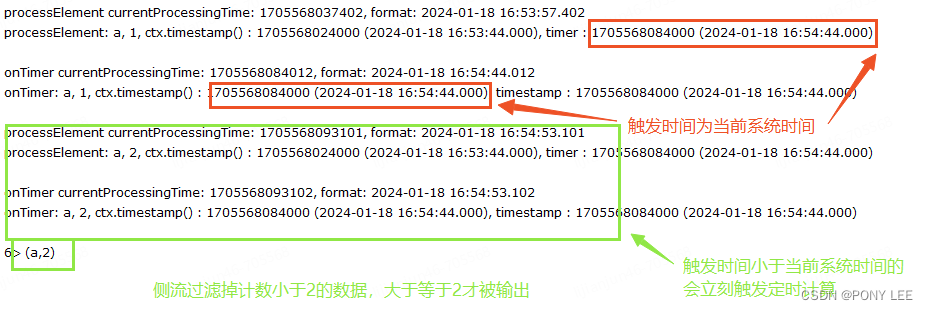Flink的KeyedProcessFunction基于Event Time和Process Time的定时器用法实例分析
发布时间:2024年01月18日
FLink处理函数简介
在Flink底层,我们可以不定义任何具体的算子(比如 map,filter,或者 window),而只是提炼出一个统一的【处理】(process)操作——它是所有转换算子的一个概括性的表达,可以自定义处理逻辑,所以这一层接口就被叫作【处理函数】(process function)。在处理函数中,我们直面的就是数据流中最基本的元素:数据事件(event)、状态(state)以及时间(time)。这就相当于对流有了完全的控制权。处理函数比较抽象,没有具体的操作,所以对于一些常见的简单应用(比如求和、开窗口)会显得有些麻烦;不过正是因为它不限定具体做什么,所以理论上我们可以做任何事情,实现所有需求。
Flink几种处理函数简介
- ProcessFunction是用于处理数据流的通用函数。它是一个抽象类,定义了处理数据流的常用方法,如processElement,onTimer等。您可以扩展ProcessFunction类并重写这些方法,以便在Flink程序中执行复杂的数据流处理逻辑。
- KeyedProcessFunction是ProcessFunction的特殊类型,用于处理带有键的数据流。它定义了额外的方法,如getKey,context.timerService()等,用于访问数据流中每个元素的键以及在处理函数中安排定时器。
- ProcessWindowFunction和ProcessAllWindowFunction是用于处理时间窗口的特殊函数。它们提供了一个process方法,用于在每个窗口中对数据进行处理。ProcessWindowFunction接受带有键的数据流,并且每个窗口都对应于一个键,而ProcessAllWindowFunction接受不带键的数据流,并且每个窗口都包含整个数据流。
这里重点介绍KeyedProcessFunction,KeyedProcessFunction是用来处理KeyedStream的。每有一个数据进入算子,则会触发一次processElement()的处理。它还提供了定时器的功能,在在预警、监控等场景特定场景下,非常适合。
KeyedProcessFunction定时器包分为两种:基于事件时间、基于处理时间。下面以统计计数的方式展示这两种定时器的用法,并附上详细的分析思路。以下用例基于Flink1.14
实例分析
KeyedProcessFunction基于事件时间的定时器
代码:
import org.apache.flink.api.common.eventtime.SerializableTimestampAssigner;
import org.apache.flink.api.common.eventtime.WatermarkStrategy;
import org.apache.flink.api.common.functions.MapFunction;
import org.apache.flink.api.common.state.ValueState;
import org.apache.flink.api.common.state.ValueStateDescriptor;
import org.apache.flink.api.java.tuple.Tuple2;
import org.apache.flink.configuration.Configuration;
import org.apache.flink.streaming.api.datastream.DataStream;
import org.apache.flink.streaming.api.environment.StreamExecutionEnvironment;
import org.apache.flink.streaming.api.functions.KeyedProcessFunction;
import org.apache.flink.util.Collector;
import org.apache.flink.util.OutputTag;
import java.text.SimpleDateFormat;
import java.time.Duration;
import java.util.Date;
/**
* @description:
*
* @author pony
* @date 2024/1/17 20:55
* @version 1.0
* nc -l 9999
*/
public class KeyedProcessFunctionOnTimerEventTime {
public static void main(String[] args) throws Exception {
StreamExecutionEnvironment env = StreamExecutionEnvironment.getExecutionEnvironment();
WatermarkStrategy<String> watermarkStrategy = WatermarkStrategy
.<String>forBoundedOutOfOrderness(Duration.ofSeconds(60))
.withTimestampAssigner(new SerializableTimestampAssigner<String>() {
@Override
public long extractTimestamp(String element, long recordTimestamp) {
return Long.valueOf(element.split(",")[1]);
}
})
.withIdleness(Duration.ofSeconds(1));
DataStream<Tuple2<String, Long>> stream0 = env.socketTextStream("x.x.x.x", 9999)
.assignTimestampsAndWatermarks(watermarkStrategy) //必须在数据源上指定watermark
.map(new MapFunction<String, Tuple2<String, Long>>() {
@Override
public Tuple2<String, Long> map(String value) throws Exception {
return new Tuple2<String, Long>(value.split(",")[0], Long.valueOf(value.split(",")[1]));
}
});
// apply the process function onto a keyed stream
DataStream<Tuple2<String, Long>> result = stream0
.keyBy(value -> value.f0)
.process(new CountEventTimeWithTimeoutFunction());
result.print();
env.execute("KeyedProcessFunction wordCount");
}
/**
* The implementation of the ProcessFunction that maintains the count and timeouts
*/
static class CountEventTimeWithTimeoutFunction
extends KeyedProcessFunction<String, Tuple2<String, Long>, Tuple2<String, Long>> {
private ValueState<Long> state;
private static final Integer DELAY = 1000; //1s
@Override
public void open(Configuration parameters) throws Exception {
state = getRuntimeContext().getState(new ValueStateDescriptor<>("myState", Long.class));
}
@Override
public void processElement(
Tuple2<String, Long> value,
Context ctx,
Collector<Tuple2<String, Long>> out) throws Exception {
Long current = state.value();
if (current == null) {
current = 0L;
}
current++;
state.update(current);
//获取当前数据流的水位线
long currentWatermark = ctx.timerService().currentWatermark();
// long timer = ctx.timestamp() + DELAY;//设置定时器的时间为当前event time+DELAY
long timer = currentWatermark + DELAY;//设置定时器的时间为当前水位线+DELAY
//注册事件时间定时器,与watermark绑定,必须满足条件: watermark >= timer 来触发特定event的定时器
ctx.timerService().registerEventTimeTimer(timer);
//删除事件时间定时器
if (currentWatermark < 0) {
ctx.timerService().deleteEventTimeTimer(timer);
}
System.out.println("last Watermark: " + currentWatermark + ", format: " + time(currentWatermark));
// 打印信息,用于核对数据
System.out.println(String.format("processElement: %s, %d, ctx.timestamp() : %d (%s), timer : %d (%s)\n",
ctx.getCurrentKey(),
current,
ctx.timestamp(),
time(ctx.timestamp()),
timer,
time(timer)));
}
@Override
public void onTimer(
long timestamp, //定时器触发时间,等于以上的timer
OnTimerContext ctx,
Collector<Tuple2<String, Long>> out) throws Exception {
// 取得当前单词
String currentKey = ctx.getCurrentKey();
// get the state for the key that scheduled the timer
Long result = state.value();
// 打印数据,用于核对是否符合预期
System.out.println(String.format("onTimer: %s, %d, ctx.timestamp() : %d (%s), timestamp : %d (%s)\n",
currentKey,
result,
ctx.timestamp(),
time(ctx.timestamp()),
timestamp,
time(timestamp)));
System.out.println("current Watermark: " + ctx.timerService().currentWatermark() + ", format: " + time(ctx.timerService().currentWatermark()));
out.collect(new Tuple2<String, Long>(currentKey, result));
}
@Override
public void close() throws Exception {
super.close();
state.clear();
}
}
public static String time(long timeStamp) {
return new SimpleDateFormat("yyyy-MM-dd HH:mm:ss.SSS").format(new Date(timeStamp));
}
}
测试数据:
nc -l 9999
a1,1704038400000
a1,1704038401000
a1,1704038403000
运行结果:

KeyedProcessFunction基于处理时间的定时器
代码:
import org.apache.flink.api.common.eventtime.SerializableTimestampAssigner;
import org.apache.flink.api.common.eventtime.WatermarkStrategy;
import org.apache.flink.api.common.functions.MapFunction;
import org.apache.flink.api.common.state.ValueState;
import org.apache.flink.api.common.state.ValueStateDescriptor;
import org.apache.flink.api.java.tuple.Tuple2;
import org.apache.flink.configuration.Configuration;
import org.apache.flink.streaming.api.datastream.DataStream;
import org.apache.flink.streaming.api.environment.StreamExecutionEnvironment;
import org.apache.flink.streaming.api.functions.KeyedProcessFunction;
import org.apache.flink.util.Collector;
import org.apache.flink.util.OutputTag;
import java.text.SimpleDateFormat;
import java.time.Duration;
import java.util.Date;
/**
* @description:
*
* @author pony
* @date 2024/1/17 20:55
* @version 1.0
* nc -l 9999
*/
public class KeyedProcessFunctionOnTimerProcessTime {
public static void main(String[] args) throws Exception {
StreamExecutionEnvironment env = StreamExecutionEnvironment.getExecutionEnvironment();
WatermarkStrategy<String> watermarkStrategy = WatermarkStrategy
.<String>forBoundedOutOfOrderness(Duration.ofSeconds(60))
.withTimestampAssigner(new SerializableTimestampAssigner<String>() {
@Override
public long extractTimestamp(String element, long recordTimestamp) {
// return System.currentTimeMillis();
return Long.valueOf(element.split(",")[1]);
}
})
.withIdleness(Duration.ofSeconds(1));
DataStream<Tuple2<String, Long>> stream0 = env.socketTextStream("x.x.x.x", 9999)
.assignTimestampsAndWatermarks(watermarkStrategy) //必须在数据源上指定watermark
.map(new MapFunction<String, Tuple2<String, Long>>() {
@Override
public Tuple2<String, Long> map(String value) throws Exception {
return new Tuple2<String, Long>(value.split(",")[0], Long.valueOf(value.split(",")[1]));
}
});
// apply the process function onto a keyed stream
DataStream<Tuple2<String, Long>> result = stream0
.keyBy(value -> value.f0)
.process(new CountProcessTimeWithTimeoutFunction());
result.print();
env.execute("KeyedProcessFunction wordCount");
}
static class CountProcessTimeWithTimeoutFunction
extends KeyedProcessFunction<String, Tuple2<String, Long>, Tuple2<String, Long>> {
private ValueState<Long> state;
private static final Integer DELAY = 60 * 1000; //1s
@Override
public void open(Configuration parameters) throws Exception {
state = getRuntimeContext().getState(new ValueStateDescriptor<>("myState", Long.class));
}
@Override
public void processElement(
Tuple2<String, Long> value,
Context ctx,
Collector<Tuple2<String, Long>> out) throws Exception {
Long current = state.value();
if (current == null) {
current = 0L;
}
current++;
state.update(current);
long timer = ctx.timestamp() + DELAY;//设置定时器的时间为当前event time+DELAY
//注册处理时间定时器, 与watermark无关,定时器触发条件:当前系统时间>timer
ctx.timerService().registerProcessingTimeTimer(timer);
//删除处理时间定时器
// ctx.timerService().deleteProcessingTimeTimer(timer);
System.out.println("processElement currentProcessingTime: " + ctx.timerService().currentProcessingTime() + ", format: " + time(ctx.timerService().currentProcessingTime()));
// 打印所有信息,用于核对数据
System.out.println(String.format("processElement: %s, %d, ctx.timestamp() : %d (%s), timer : %d (%s)\n",
ctx.getCurrentKey(),
current,
ctx.timestamp(),
time(ctx.timestamp()),
timer,
time(timer)));
}
@Override
public void onTimer(
long timestamp,
OnTimerContext ctx,
Collector<Tuple2<String, Long>> out) throws Exception {
// 取得当前单词
String currentKey = ctx.getCurrentKey();
// get the state for the key that scheduled the timer
Long result = state.value();
System.out.println("onTimer currentProcessingTime: " + ctx.timerService().currentProcessingTime() + ", format: " + time(ctx.timerService().currentProcessingTime()));
// 打印数据,用于核对是否符合预期
System.out.println(String.format("onTimer: %s, %d, ctx.timestamp() : %d (%s), timestamp : %d (%s)\n",
currentKey,
result,
ctx.timestamp(),
time(ctx.timestamp()),
timestamp,
time(timestamp)));
//另外还支持侧流
OutputTag<Tuple2<String, Long>> outputTag = new OutputTag<Tuple2<String, Long>>("single"){};
if (result < 2) {
ctx.output(outputTag, new Tuple2<>(currentKey, result));
} else {
out.collect(new Tuple2<String, Long>(currentKey, result));
}
}
@Override
public void close() throws Exception {
super.close();
state.clear();
}
}
public static String time(long timeStamp) {
return new SimpleDateFormat("yyyy-MM-dd HH:mm:ss.SSS").format(new Date(timeStamp));
}
}
测试数据:
nc -l 9999
a,1705568024000
a,1705568024000
运行结果:

总结
在真实业务场景中【 KeyedProcessFunction基于处理时间的定时器】用的比较多,比较符合业务场景,即根据事件的时间来指定处理时间去定时触发定时器。因此在此场景中,可以不指定watermarkStrategy,可以获取传输参数的时间时间来定时触发定时器。
文章来源:https://blog.csdn.net/weixin_38251332/article/details/135679590
本文来自互联网用户投稿,该文观点仅代表作者本人,不代表本站立场。本站仅提供信息存储空间服务,不拥有所有权,不承担相关法律责任。 如若内容造成侵权/违法违规/事实不符,请联系我的编程经验分享网邮箱:chenni525@qq.com进行投诉反馈,一经查实,立即删除!
本文来自互联网用户投稿,该文观点仅代表作者本人,不代表本站立场。本站仅提供信息存储空间服务,不拥有所有权,不承担相关法律责任。 如若内容造成侵权/违法违规/事实不符,请联系我的编程经验分享网邮箱:chenni525@qq.com进行投诉反馈,一经查实,立即删除!
最新文章
- Python教程
- 深入理解 MySQL 中的 HAVING 关键字和聚合函数
- Qt之QChar编码(1)
- MyBatis入门基础篇
- 用Python脚本实现FFmpeg批量转换
- ubuntu server配置无线网络
- JAVEE初阶 多线程基础(九)
- 实验二 体系结构
- docker swarm 常用命令简介以及使用案例
- 1.苍穹外卖-day01
- BikeDNA(八)外在分析:OSM 与参考数据的比较2
- hyperf 和 laravel、lumen防止xss攻击中间件封装
- vue保姆级教程----深入了解 Vue3与Vue2的区别对比
- 2022年全国职业院校技能大赛网络安全竞赛试题1-10-B模块总结
- 理论U2 贝叶斯决策理论